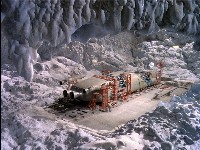Phoenix
Click images for larger view. Thanks to Marcus Lindroos for comments.

The Phoenix is reconstructed in an ice cave on Ultima Thule, in a scene from Death's Other Dominion. The Phoenix is seen only from this rear 3/4 angle, for a matter of seconds.

This wider view only appears in the This Episode sequence.

The original design for the Phoenix, by Brian Johnson, closely resembles the Discovery from 2001: A Space Odyssey (1968). The storage pods around the central spine are similar to those on the Meta Probe seen in Breakaway.

This is a Brian Johnson sketch showing the view that would be seen on screen (on the design for the alien tower from War Games).

The design by model-maker Martin Bower. Martin Bower in Sci Fi and Fantasy Models 13: The only model I produced from a glass fibre shell was the Phoenix. I cheated as I used a casting I'd already made for another model. I cut the casting into segments and filled in the gaps with girder work, taken mainly from Faller Bridge and railway accessory kits The craft was meant to represent a spaceship under construction within the storyline. So I built the model, which was about 4 feet long, on a blockboard base. The detailing on the base was done using roadway parts from an old Minic Motorway set turned upside down. The model took a great deal of time as it is seen surrounded by all sorts of detailed support gantries. But I regret to say very little of this is seen in the final cut where the model only appears on screen for two 2 second shots! A bit of a shame as far as I'm concerned as it was one of my favourite models.
The Phoenix is unlike other Earth spaceships seen in Space: 1999, with smooth lines. Other craft, like the Eagle, Swift, Hawk or Ultra Probe have complicated detailing and a characteristic cone-like command module with inset viewports. The Phoenix looks like a 1950s design- and in fact it was inspired by the rocket ship in the 1950 film When Worlds Collide.
The Phoenix is also much larger than other terrestrial craft. The small building and crane visible in the foreground of the diorama suggests it is 100 metres in length or more. It also carries an unusually large crew of 20-30 astronauts; this is possibly because Uranus is a very distant planet and consequently both spacecraft and crew will have to be completely self-supporting for many years in deep space. Remarkably, the ship is capable of atmospheric entry and landing on Ultima Thule despite its huge size, so it presumably utilises antigravity technology.

The rear view. This was shot after filming; the rear rocket bells are missing. They were used on the Eagle strap-on boosters.

The Phoenix with the original engines in place. Among the obvious kit parts, the longitudinal ducts of the SR.N1 hovercraft can be seen on the base just under the engines. The scaffolding is Faller girder bridges (for model railways).
Copyright Martin Willey